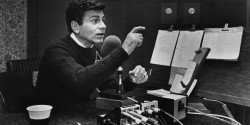Broadcasting legend Casey Kasem passed away Sunday at the age of 82. For those who grew up in the 70s and 80s Kasem is an icon of classic pop radio. His passing is sad, but causes me to reflect on how a single weekly broadcast so neatly encapsulated American music culture for a time, and how that time is also passed.
I listened to America’s Top 40 pretty religiously as a kid in the 1980s. In many ways it was a show perfectly designed for a slightly nerdy 10 year-old glued to his radio much of the time. Whether it was disco from the Bee Gees and Donna Summer, or hard rock from Cheap Trick and Loverboy, Kasem always sounded equally interested, as he relayed bits of trivia about the bands’ origins, their album names or their background.
I listened most often in AT40’s second decade, before the internet, but already a time when commercial radio was splintering into ever-narrower formats programmed by research, surveys and charts rather than passionate and knowledgeable DJs. While Kasem’s show truly shot down the center of the American mainstream, you could depend on hearing a diversity of genres and styles. When everything you’d want to know about Mister Mister, Duran Duran or the Thompson Twins is just a Wikipedia search away, it’s difficult to recapture the wonder of hearing Kasem fill you in on tidbits about the most popular bands that you just didn’t hear from the average minimum-wage local jock.
Oh, and the suspense! Certainly, by the time I turned 15 I was hip to how the Billboard charts failed to represent too much good music. But 4 years earlier I was utterly susceptible to the anticipation of finding out if last week’s number 1 would hold onto it spot, or tumble back to 2, 4 or, god forbid, somewhere south of the top 10. Kasem made it sound so meaningful, like a weekly World Series for young music nerds.
By the end of the 80s Kasem had–as a result of a contract dispute–moved on from America’s Top 40, and so had I. By then I was a much more cynical and world-weary college radio DJ, and a franchise like AT40 represented everything that was bloated and corrupt in the hegemony of the mainstream music and broadcast industry. Yet, for me at least, my disdain for the charts didn’t rub off onto Kasem himself.
That didn’t stop me from finding an enormous and perverse pleasure when Negativland’s infamous U2 single arrived at my station in 1991. Featuring samples of Kasem outtakes, it was utterly delightful to hear him excoriate producers with colorful explectives for having him talk about a dead dog named “Snuggles,” after coming out of an uptempo record. Much of the humor stemmed from the discord between his unflappable and wholesome persona and the frustrated and profane wordsmith these bootleg tapes revealed.
For me it humanized Kasem. Of course it’s absurd to have to do a long-distance dedication about a dead dog after a happy, uptempo song. No doubt, it gets monotonous to have to plug local stations and their unoriginal and stupid tag lines, week after week. I’d be frothing at the mouth with f-bombs, too. But put to the beat of an off-kilter U2 cover, it’s even more hilarious.
My love for Kasem is rooted in nostalgia for a time that isn’t coming back. Sure, there’s still a Billboard Hot 100 chart, but there isn’t anything we can legitimately call Top 40 radio anymore. Whether it’s the result of cynical radio industry or the increasingly individualized taste of a fickle audience–or some combination of the two–nobody’s clamoring for that kind of countdown. That includes me. While I enjoy occasionally stumbling upon classic re-runs of AT40s from the 70s and 80s, I must admit I’m not particularly interested in hearing a countdown from June 2014. I’m as guilty as anyone else.
But it’s not a pathetic kind of nostalgia. Believe me, I’m not wishing for it to be 1981 again. And I don’t get the sense that Kasem was ever desperately holding on to the past, either. Sure, he made a series of comebacks after first taking leaving of AT40 in 1989. At the same time he seemed ever-adaptable, willing to take different charts as his reference and refine the playlist to be more adult contemporary than teenage pop.
One might say that was a sell-out, but I would heartily disagree. Kasem was a broadcaster and an entertainer. That he left you believing he really cared about “these guys from England,” was evidence of his talent and craft. His audience aged, he aged, and there’s no evidence he tried to fight it.
AT40 manifested the best aspects of American hit radio, warts and all. It really was the bridge from the brief but oft-mythologized days of freeform FM in the late 60s and early 70s to the strictly formatted playlists that took over by the early 1990s. And it was sort of paradox in that regard, representing both diversity and homogenization. It was utterly national and non-local, and yet might be the only show playing some tracks on a given station. In that way it managed to be familiar, and just a little exotic, like the first taste of this strange new chipotle sauce at Applebees. So, it was also American, through and through.
Thank you, Casey, for giving this 80s kid a reason to stay glued to his radio weekend after weekend, and inspiring countless other radio nerds to try out their own voices on the broadcast mic.



